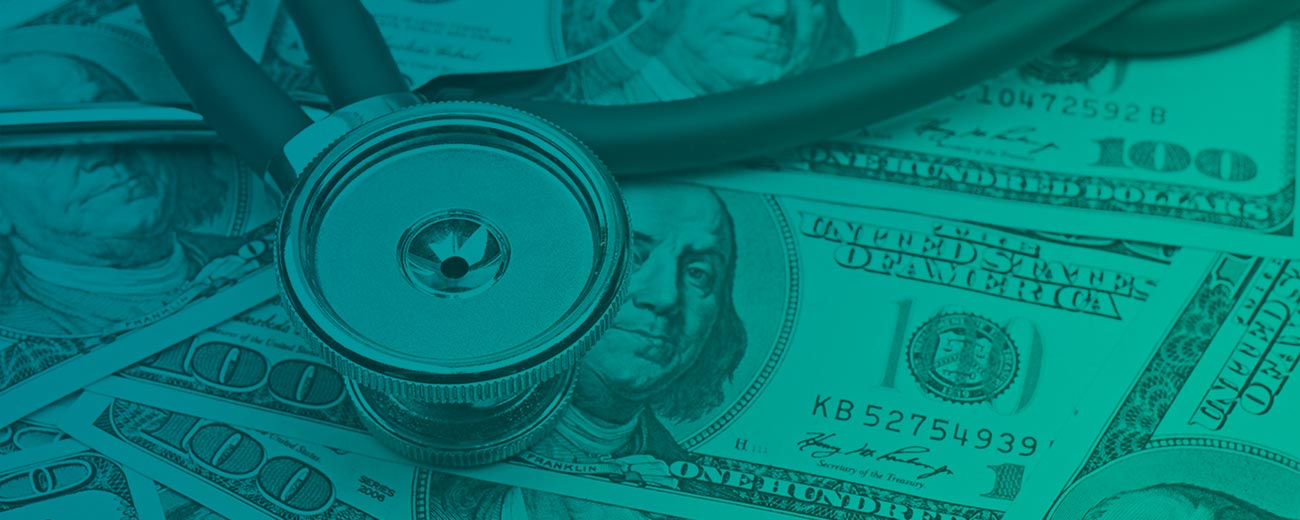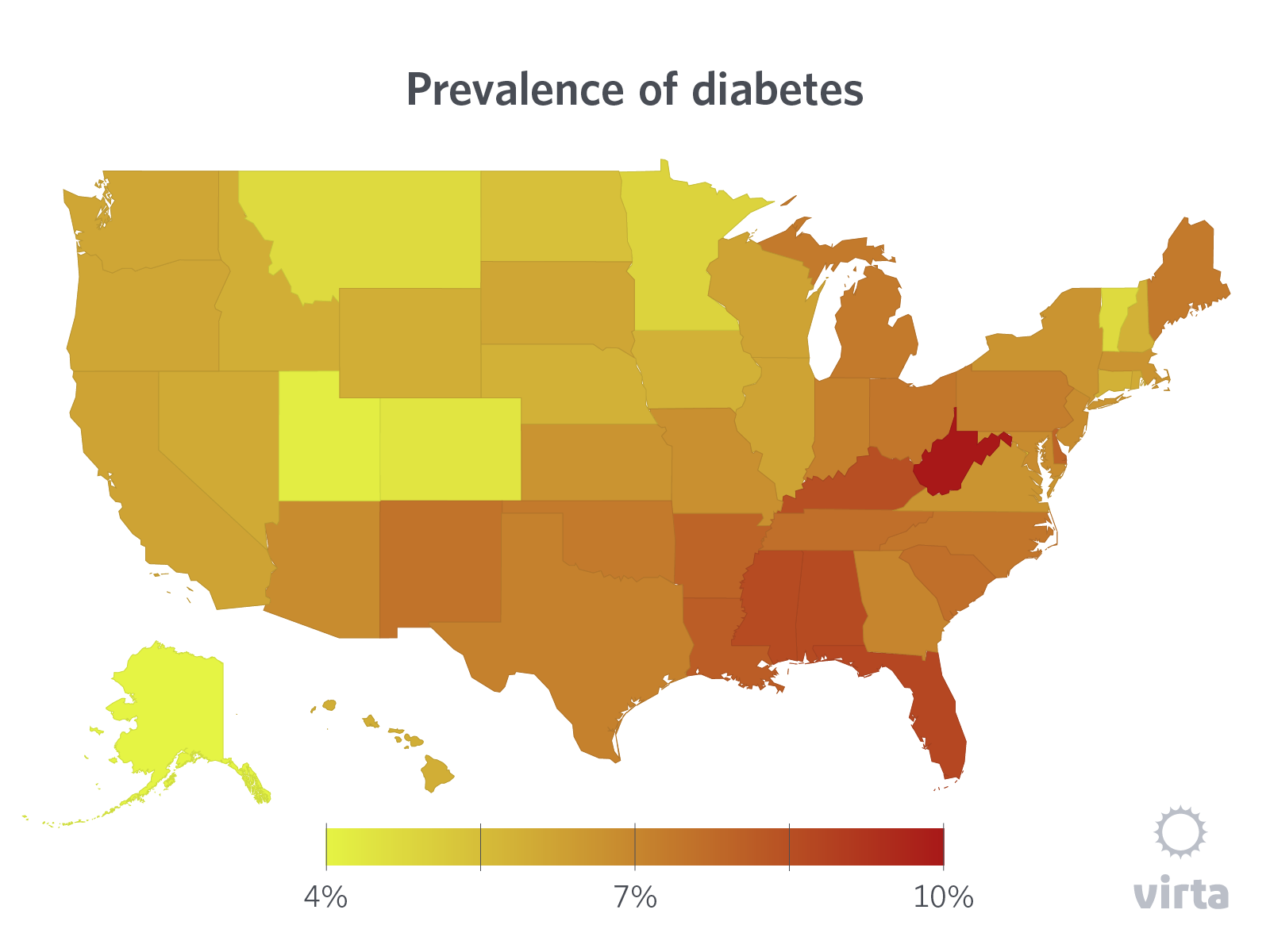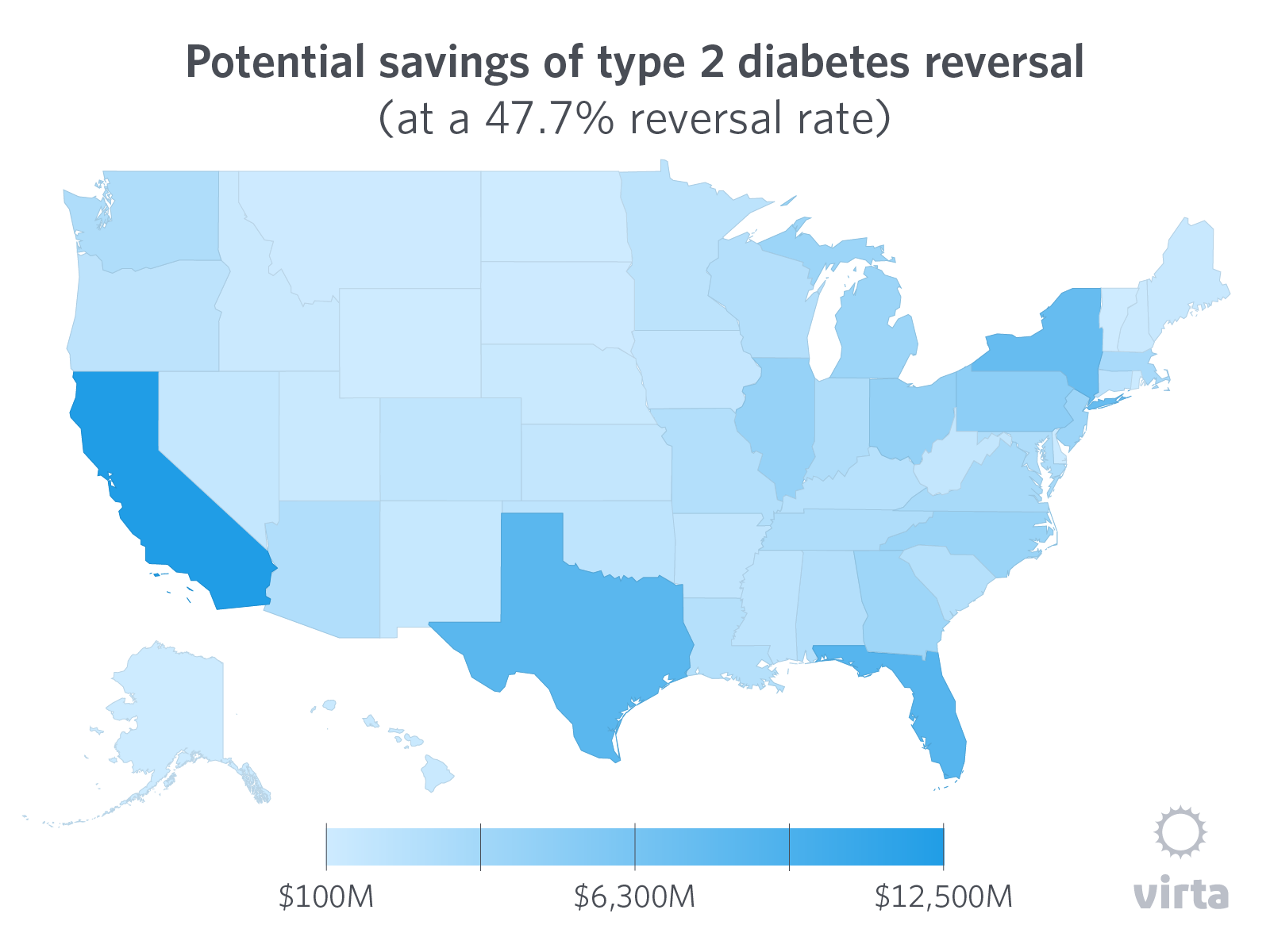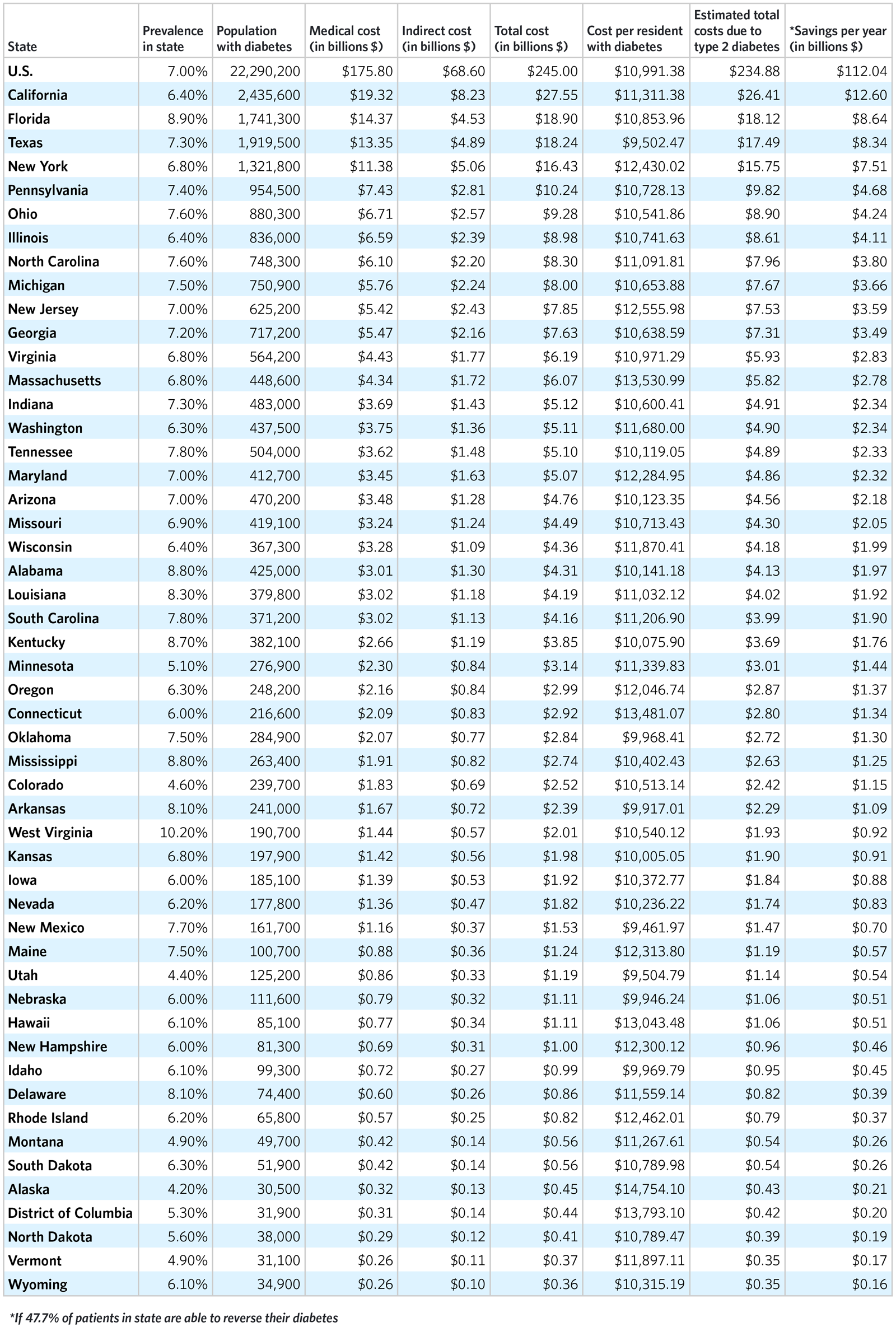
How Much Money Could Your State Save with Diabetes Reversal?

Type 2 diabetes is an epidemic of national proportions and state-level impact. Reversing type 2 diabetes—until just recently deemed chronic and progressive—stands to save lives, and to pour money back into Americans’ bank accounts and state coffers nationwide. Reversing type 2 diabetes in just a portion of those afflicted could lead to state-specific savings of $2.24 billion annually going forward, on average, according to new calculations on data from the American Diabetes Association. That’s more than a typical state spends on higher education in a year. Numbers vary state by state, determined largely by the size of the state’s population, but from jumbo California to tiny Wyoming, the potential in long-term savings is no chump change.
In fact, diabetes costs the nation $245 billion each year, counting both medical expenses and indirect expenses such as work absenteeism, according to the American Diabetes Association. That’s about 20% of all healthcare spending in the country and more than the federal budget for education. To make matters worse, those costs are climbing rapidly, up more than 40% in five years.
“We have more and more people developing diabetes, and it is costing the healthcare system enormously,” says Robert E. Ratner, M.D., Professor of Endocrinology and Metabolism at Georgetown University School of Medicine, and the former Chief Scientific & Medical Officer of the American Diabetes Association. “To the extent that we can identify [solutions] to reach those individuals in order to stem the progression of diabetes or potentially reverse it, now's the time. This is an issue that has medical consequences, sociologic consequences, and economic consequences.”
This new view of type 2 diabetes as a potentially reversible condition stems from a boom in technology and science that is allowing telemedicine to emerge as the most effective platform for treatment. In a recent study type 2 diabetes was reversed in 47.7% of patients (as defined by HbA1c reduced to levels below the diagnostic threshold for type 2 diabetes and elimination of all their diabetes medications excluding Metformin) through a digitally delivered nutritional intervention supported by physician supervision, one-on-one health coaching, biomarker tracking and education.
The potential cost savings are noteworthy. If 47.7% of cases of type 2 diabetes nationwide are reversed, and their diabetes-related costs approach $0 after the diabetes reversal, savings in subsequent years could total roughly $137 billion annually. And at a state level? For California, which leads the nation in number of people with diabetes, annual costs for type 2 alone top $26 billion; a 47.7% disease reversal with medication elimination (excluding Metformin) represents up to $12.6 billion saved in each subsequent year.
How does each state measure up?


These savings are spread across taxpayer money, individual pocketbooks, employers and more. Type 2 diabetes is an expensive condition. Compared with the general population, people with diabetes have twice as many doctor and emergency room visits, take over five times more prescription drugs and seven times more cardiovascular drugs, according to a study by the Health Care Cost Institute (HCCI), a non-profit research organization focused on healthcare spending. Those numbers drive the national and state figures, but in addition, people with diabetes spend two-and-a-half times more out of pocket for their healthcare than those without diabetes. “If we can intervene in order to prevent hospitalizations, prevent the complications of diabetes, and reduce medication costs, we're going to have a huge impact on the economics of diabetes," says Georgetown’s Ratner. “Ultimately we all pay for healthcare costs. Looking at ways that improve outcomes can only be advantageous.”
Top ten states that could save the most from type 2 diabetes reversal
California
Although California is slightly below the national average in prevalence of diabetes (6.4% versus the nation’s 7%), its large population makes it the state that stands to save the most from diabetes reversal. California spends approximately $26.41 billion annually on type 2 diabetes. The 47.7% reversal rate represents potential savings of $12.6 billion annually.
Florida
The Sunshine State has the second highest prevalence rate for diabetes in the nation, at 8.9% of the population (after West Virginia with 10.2%). Florida spends about $26.4 billion annually on type 2 diabetes. The 47.7% reversal rate represents potential savings of $12.6 billion annually.
Texas
There are 1.9 million Texans with diabetes, although the prevalence is only slightly above the national average (7.3% compared with 7%). Texas spends approximately $17.5 billion on type 2 diabetes. The 47.7% reversal rate represents potential savings of $8.3 billion annually.
New York
New Yorkers are a hair healthier than the national average, with diabetes prevalence at 6.8% versus 7%. Still, New York spends roughly $15.8 billion on type 2 diabetes. The 47.7% reversal rate represents potential savings of $7.5 billion annually.
Pennsylvania
The Keystone State has just short of a million residents with diabetes, at a rate of 7.4% of the population. Pennsylvania spends roughly $9.8 billion on type 2 diabetes. The 47.7% reversal rate represents potential savings of $4.7 billion annually.
Ohio
Ohioans with diabetes number just over 880,000, with a prevalence rate of 7.6%. As a result, the Buckeye State spends about $8.9 billion on type 2 diabetes. The 47.7% reversal rate represents potential savings of $4.2 billion annually.
Illinois
The Prairie State is below average in diabetes prevalence, with 6.4% of the population affected. However, prevalence in Chicago (Cook County) tops 8.5%. At a state level, Illinois spends roughly $8.1 billion on type 2 diabetes. The 47.7% reversal rate represents potential savings of $4.1 billion annually.
North Carolina
The home of Kitty Hawk is home to almost 750,000 people with diabetes, with a prevalence rate of 7.6%. The state spends roughly $8 billion on type 2 diabetes. The 47.7% reversal rate represents potential savings of $3.8 billion annually.
Michigan
The Great Lakes State, Michigan, has a diabetes prevalence of 7.5%, though Detroit tops 12% in prevalence of the illness. At a state level, Michigan spends about $7.7 billion on type 2 diabetes. The 47.7% reversal rate represents potential savings of $3.7 billion annually.
New Jersey
New Jersey’s incidence of diabetes matches the national average of 7%. The Garden State spends about $7.5 billion on type 2 diabetes. The 47.7% reversal rate represents potential savings of $3.6 billion annually.
Diabetes reversal state by state

How can type 2 diabetes be reversed?
A peer-reviewed clinical trial of people with type 2 diabetes shows that the illness can be reversed through a telemedicine-facilitated nutritional intervention supported by physician supervision, coaching and educational resources. Reversal in this case means an HbA1c reduced to levels below the diagnostic threshold for type 2 diabetes and elimination of diabetes medications other than metformin.
Costs of type 2 diabetes reversal vary. Although bariatric surgery can cost tens of thousands of dollars, a physician-supervised nutritional intervention can cost only a few thousand dollars.
Methodology
This data is a rough estimate of costs and cost savings.
We used data from the American Diabetes Association. The data accounts for all forms of diabetes, including both type 1 and type 2. Around 4.13% of people with diabetes are type 1, so to get a rough estimate of the spending on type 2, we excluded 4.13% of the costs from the data. This is an imperfect measurement because some type 1 diabetics may be on more medications or have higher costs than the average type 2 diabetic.
Savings were estimated using a 47.7% reversal with diabetes medication elimination (excluding Metformin) rate, which has been shown to be possible in a clinical trial. For the purposes of this estimate, we assumed that diabetes-related costs would be brought down to $0/year, after the cost incurred in reversing the condition. The cost of the diabetes reversal treatment was not included in this analysis. It is possible that patients whose type 2 diabetes has been reversed may incur additional diabetes-related costs throughout their lifetime, including doctor’s visits, costs associated with potential relapses, and other costs. Patients who remain on Metformin may incur a small diabetes-related cost for the Metformin, any associated doctor’s visits, and likely minimal indirect costs.
Learn More
Interested to learn more about developments in diabetes reversal? Feel free to contact us.
This blog is intended for informational purposes only and is not meant to be a substitute for professional medical advice, diagnosis, or treatment. Always seek the advice of your physician or other qualified health provider with any questions you may have regarding a medical condition or any advice relating to your health. View full disclaimer
Are you living with type 2 diabetes, prediabetes, or unwanted weight?






.jpg)

